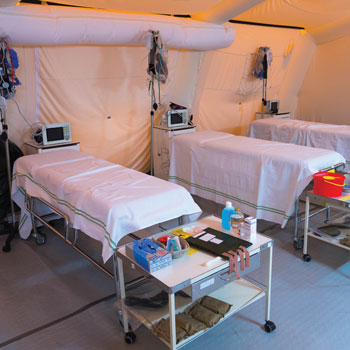What to expect when volunteering in war-torn regions
A new training program simulates a humanitarian crisis and teaches physicians how to determine basic living needs and the health care infrastructure required to meet them.
After graduating from college, ACP Member Sarah M. Kesler, MD, traveled to Namibia, Africa, to teach mathematics. “It was really an exciting time because it had recently gained independence from South Africa and was no longer under the system of apartheid. Namibian citizens were trying to rebuild their own country and become independent,” she said.
Dr. Kesler remembers tuning in to a shortwave radio (it was 1995) and listening to a group of enthusiastic physicians who were stationed somewhere to the north, in central Africa. “And I thought, ‘Oh wow, that sounds really neat.’ I was thinking about what to do next, and that's part of why I applied to medical school,” she said.
After finishing her medical training, Dr. Kesler completed overseas missions from 2005 to 2011 in Sudan, South Sudan, Uganda, Chad, and the Philippines as part of her work with Doctors Without Borders (aka Médecins Sans Frontières), a medical humanitarian nongovernmental organization. Last October, the ACP Minnesota Chapter awarded her the 2016 Community Volunteer Award for her service.

Board certified in both internal and critical care medicine, Dr. Kesler is an assistant professor of medicine at the University of Minnesota Medical Center in Minneapolis and, in her most recent role, directs the university's annual international humanitarian crisis simulation course, which is based on her experiences overseas. She recently spoke with ACP Internist about the surprises she encountered overseas and how motherhood changed her course.
Q: Why is volunteering so important to you as a physician?
A: I went to medical school in part because I was hoping to work overseas. I think the further along in your career you get, the more you see how incredibly overprivileged you are, and the more skills and experience you accrue, the more you feel like you want to go and share some of that good fortune with other people.
Q: Can you speak about your role with Doctors Without Borders?
A: When you're going overseas and you're working for Doctors Without Borders, you do some direct patient care, but more of what you do is supervision, training, and project management. I think a lot of doctors have a misconception about what they'll do when they do aid work. They get there and they go, “Well, wait a minute. I thought I was going to be bandaging people up.” And what you're actually doing is project management. You're supervising the people who are bandaging people up. And you're managing the inventory, and you're surveying for epidemics, and monitoring the overall quality of the operation, for example.
Q: What were the care settings that you worked in while overseas?
A: I've been in a wide variety of settings. I've been in settings where it's the real initial stages of a refugee crisis and you're just literally setting up, kind of like you're backpacking. You're sleeping in those conditions, you've got a few boxes of medical supplies, and you're just kind of doing primary care. I've also worked in other settings alongside professionals in government-run hospitals. In all the missions I've done, regardless of the context, the majority of patients are children and women. In most modern conflicts, in fact, the majority of casualties are civilian rather than combatant.
Q: How long were you overseas with each mission?
A: Usually about three months. The longest I ever went was six months. It's really hard with [Doctors Without Borders] to be able to go for much less than that because it's hard to get in somewhere and be effective in a real short period of time, for the most part.
Q: What are your current volunteer efforts?
A: I have a three-and-a-half-year-old, and I'm trying to figure out how I can get back into working overseas. Right now, I'm volunteering my time at home. We created the [humanitarian crisis simulation] course to train people who are interested in learning more about the profession of humanitarian aid work, or who are interested in learning more about the experience of refugees. It's been great because that's been a way that I've been able to stay engaged with the field despite being at home for the last three years. It's a three-day course, and we train about 70 people. This last year, we trained 40 graduate students, some resident doctors, some practicing doctors, and then junior-level aid workers, ranging in age from 23 to 60.
Q: What does the course entail?
A: The idea is to try to give people just a basic understanding of what kinds of skills and knowledge they would need to manage a large humanitarian crisis, as well as a deeper understanding of the experiences of both humanitarian aid workers and refugees. We have about eight hours of didactic sessions, followed by 48 hours where we simulate a humanitarian crisis, like maybe something on the border of Chad and Sudan, or the Democratic Republic of the Congo and Uganda. The area is inherently unstable with poor infrastructure and then experiences a crisis, with a mass movement of refugees from one side of the border to another.
We simulate the crisis with about 150 role players and a very elaborate scenario and script. After the lectures, the students are divided into teams. They have to wander around this area, encounter all these role players, and try to figure out: How many people are living here, how much food do they have, how much water do they have, what is the medical infrastructure, are there any disease outbreaks? And then they present a proposal for an intervention at the end of the course.
Q: Did you help create that course based on your own experience?
A: Yes, I did. It was kind of serendipitous: The year right before I had my son, it was given to me as a volunteer project. This career aid worker and I created this fictional world based on both our experiences. It was initially a little experimental 24-hour event, but every year it gets a little bigger, and it's been hard to stop doing it. I've learned a ton. I think it's a really valuable training for two reasons. First, if people, especially clinicians, do decide to go do something like Doctors Without Borders, they're a little bit more prepared. People assume that they will be working strictly within their profession, but working in a humanitarian crisis requires a very broad range of skills. Second, the people who take our course but have no plans to go overseas tell us their understanding of the experience of refugees is much deeper as a result.
Q: Can you share a story of a patient you helped overseas?
A: When you think about all the kids that you're treating overseas, there's so many that it's hard to pick just one case.
I do remember one kid who had bad meningitis, and we were in Darfur [in western Sudan]. That was my longest mission. We had traveled through this border area, so we were right by a mountain called the Jebel Marra. The mountain area was controlled by rebels, so you had to cross this border to go and help the population that was sort of trapped up in this area. They couldn't move out of where the rebels held territory, and I remember a little boy who had meningitis. I don't know what kind—we weren't able to test—but he had meningitis so bad that he was unconscious, and we had to transport him back [to receive care], and it took us two hours to transport him back through roadblocks. It took his family a full day because they had to walk, so they didn't arrive until the next day. He went home completely normal, and it was amazing.
The sad thing about that was during that trip, we ended up treating some combatants, and then the government responded by shutting the whole project down. We couldn't travel there anymore.
Q: What was it like to treat children as an internist?
A: That was something that I was not very well prepared for. The nice thing about working with Doctors Without Borders in particular is that they give you a lot of support, a lot of references, and so if you've got clinical training, you can educate yourself fairly quickly.
Q: Any tips for physicians who are interested in international aid?
A: When I went overseas with Doctors Without Borders, first I just kind of had this idea that I would go and volunteer and I would come back and start my normal life. I had already signed on for a job before I came home, and I got over there and realized that there's this huge, huge world and that it's actually an entire career path in and of itself to go, and there's all kinds of leadership positions and interesting things you can do. So whenever young people come into my office and ask for advice, I tell them that. A lot of times, they're surprised because they kind of have this idea that “I'll go and volunteer my time.” No, it's a career.
On the other end of the spectrum, with Doctors Without Borders, the oldest first-time volunteer that I ever worked with was 70, and that was in the Democratic Republic of the Congo. There is no age limit. If somebody thinks that that's something that they want to do, there's no reason that they can't think about doing it at whatever age they're at. Also, if you really think you want to do it, give yourself a good amount of space to take the time. Don't think that you're just going to go over for a month and get the full experience.




